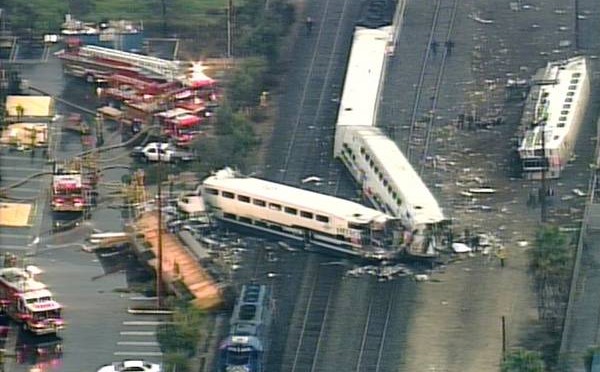Kenneth Piper, January 23, 2014
In January, 2005, a Metrolink train running in “push configuration” struck a vehicle that was abandoned on the tracks, and derailed. The derailment also caused a secondary derailment of a train going the opposite direction on an adjacent track. Eleven people died as a result of this accident, and over 100 were injured.
At the time, there was criticism of the policy of running trains in push mode. But Metrolink and Amtrak continue this practice. It is unsafe and unnecessary. Metrolink officials claim that it is safe — although they now prohibit passengers from the front half of the leading car.
Anyone who has taken high school Physics can understand why it is unsafe. There are several dangers with the configuration. First, a train is dynamically unstable when pushed. To understand this, take a group of cars connected together (a model train can be used) without a track. If you pull them from the front, the trailing cars will follow. If you push from the rear, they will invariably collapse into some variation of a snaking fashion. Of course, that is why they are on rails. But what keeps them on the rails?
The wheels are tapered (larger on the inner edge) so that the axle will tend to be centered on the tracks, and also so that the outer wheel will have a larger effective diameter in a turn. There are also flanges on the inner side of the wheels, which are intended to prevent the wheels from jumping the rail if anything tends to push the axle too far to one side. This is especially important for curves in the track. The flanges are about an inch on a typical 40″ diameter wheel. Not much, so it is really the weight on the wheels that keeps the train on the tracks.
The following tables give the weights for typical Metrolink and Amtrak passenger cars and locomotives. They also give the weight per axle (these are all 4-axle configurations).
Weights of Typical Metrolink and Amtrak passenger cars
| Train car | Weight (lb.) | Weight per axle (lb.) |
| Metrolink bi-level passenger car | 110,000 – 134,000 | 27,500 – 33,500 |
| Amtrak single level car | 104,000-111,000 | 26,000 – 27,750 |
| Amtrak bi-level car | 150,000-154,000 | 37,500 – 38,500 |
Weights of typical Metrolink and Amtrak locomotives
| Locomotive | Weight (lb.) | Weight per axle (lb.) |
| Metrolink EMD F59PHI | 265,000 | 66,250 |
| Amtrak GE P42DC | 268,000 | 67,000 |
As you can see, locomotives weigh about twice as much as passenger cars, and correspondingly have about twice the weight per axle. It’s a lot of weight per axle, which is why they generally stay on the tracks. But it’s also true that the locomotives are much less likely to get dislodged from the tracks.
So the dynamic stability of a pull configuration versus the dynamic instability of the push configuration, combined with the differences in weight on the track make it clear that a pull configuration is less likely to get dislodged from the tracks. But what else happens in a train collision? Even if there is no derailment, it is much better to have the heavy locomotive in the front, taking the brunt of the collision.
That is because it has about twice the momentum of the passenger cars. If a passenger car is in the front in a head-on collision, it will take the full force of the train’s momentum (an average Metrolink train is about 400 tons, or 800,000 lb.; Amtrak trains are typically longer and correspondingly heavier). But I would not want to be in the last car either, because the heavy locomotive will be slamming right into that car. On the other hand, if the locomotive is in the front, it will be taking the force of the entire train, and the lighter passenger cars to the rear will not have the same impact on the passenger cars in front of them.
It is clear that the pull configuration is better. So why do we still have trains running backwards? It is because they don’t want to turn the trains around. Turning the entire train around requires a wye in the tracks. They have one of these at Los Angeles Union Station. The train can be pulled into the wye, and backed out on the other side, so that the train will now be facing the other direction. As the various trains have different end destinations, you would need wyes at all the possible turnaround points. This requires a lot of space. But there is a simple alternative.
Many electric locomotives (and some diesel-electrics) have two-ended configurations. To go the other way, the engineer just walks to the other end of the engine. (With the style locomotives commonly used for freight duty, they may only need to move a few feet.) Longer trains have two locomotives, often with one facing each way. So all that is needed is a passing track. The locomotive can be uncoupled from the passenger cars and run around on the siding to the other end. If it is desirable for the passengers to face in the direction of travel, you can have reversing seats. Amtrak coach cars I have been on have reversible seats. I don’t know about Metrolink cars. Sometimes they have pairs of seats facing each other to facilitate conversation.
The solution is simple, although it does involve cost for either new locomotives, or modifications to existing locomotives. But I see no movement in this direction. I keep wondering whether the reluctance to change this practice is really a reluctance to admit they are wrong, which is really an admission of negligence. And the lawsuits would follow…

